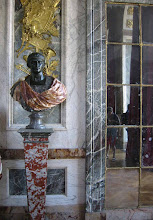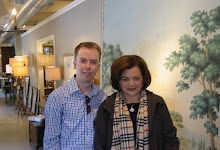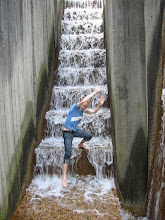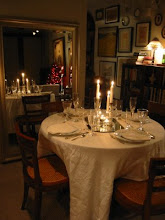Just in time for the Christmas shopping season Phaidon has released a book perfect for the architecture lover on your list, Drawing Architecture by Helen Thomas. Above is a recent rendering by Grafton Architects done with computer software in 2013. Unlike most computer renderings, notice how soft and beautiful it is. This transforms what is ordinarily a cold lifeless drawing into an art form; I'd hang this on my wall!
Showcasing over 250 drawings by architects from Bernini to Frank Gehry and Michelangelo to Renzo Piano, the book highlights how styles have changed but the way architecture is represented has mostly stayed the same. Above is a sketch completed by set designer Ferdinando Galli da Bibiena in 1732 of a piece of scenery for the baroque stage. Notice the clever way the elevation and plan are represented together.
Lastly I wanted to share a rendering from 1939 by architect Ernesto Bruno la Padula of one of my favorite buildings in Rome, the Palace of Italian Civilization. While this was completed after the building was complete, these types of renderings are instrumental in working with clients.
Author Helen Thomas is a trained architect and writer who works at the London V&A museum in London that I just had the pleasure of visiting (lucky her!). Definitely add this book to your shopping list, perfect for any lover of architecture or even just drawings.
All images courtesy of Phaidon
Monday, December 3, 2018
Monday, October 22, 2018
Interior Landmarks - Treasures of New York
Everyone is familiar with the many landmarks of New York City, but thanks to Judith Gura and Kate Wood (courtesy of the Monacelli Press) we are all about to become familiar with the landmarked INTERIORS of the city.
Since 1965 the New York City Landmarks Law has been protecting significant spaces across the city ranging from classical architecture to more unexpected masterpieces of the modern era.
This book includes 120 landmarks and their locations which can be used as an architectural tour guide of the city as most spaces are open to the public.
The projects range from the expected such as the Metropolitan Museum by Richard Morris Hunt seen below -
To the lesser known such as the Loews Paradise Theater in the Bronx by John Eberson.
The re-release of this book includes updated information with new additions so that you can explore these landmarks for yourself.
I think a copy of this book is a must-have guide to the city with more interesting venues than the typical tourist guidebook but can also be used for more serious research. In a city that is constantly changing the struggle to preserve our architectural heritage is in more need of support than ever! Happy Reading!
All images courtesy of Larry Lederman and The Monacelli press
Since 1965 the New York City Landmarks Law has been protecting significant spaces across the city ranging from classical architecture to more unexpected masterpieces of the modern era.
This book includes 120 landmarks and their locations which can be used as an architectural tour guide of the city as most spaces are open to the public.
The projects range from the expected such as the Metropolitan Museum by Richard Morris Hunt seen below -
To the lesser known such as the Loews Paradise Theater in the Bronx by John Eberson.
The re-release of this book includes updated information with new additions so that you can explore these landmarks for yourself.
I think a copy of this book is a must-have guide to the city with more interesting venues than the typical tourist guidebook but can also be used for more serious research. In a city that is constantly changing the struggle to preserve our architectural heritage is in more need of support than ever! Happy Reading!
All images courtesy of Larry Lederman and The Monacelli press
Monday, October 15, 2018
Private Classical Baltimore home tour this weekend!
This upcoming weekend I'm helping to host a home tour in Baltimore for our local chapter of the ICAA which I've decided to name Private Classical Baltimore. Read here for a little information about this tour which I'm so excited for!
The tour starts at the Homewood Mansion on Johns Hopkins University campus. Built and designed by Charles Carroll Jr. for his family in 1801, the house has a Palladian 5-part plan. While planned and massed in the Georgian style of the time, it uses Federal-style detailing reflecting the influences of Robert Adam. The flatter details seen here distinguish the federal style from the English Georgian style and this is considered one of the best federal examples in the country. Lunch will be served as part of the tour in the garden, weather permitting.
After lunch the tour will progress to 2 beautiful historic houses in the Homeland neighborhood. The stone house seen here was designed by Palmer & Lamdin in 1928. They were the preeminent residential architects in Baltimore between the wars. Edward Palmer was an 1899 graduated of Johns Hopkins and in the 1903 class of the University of Pennsylvania school of architecture. In 1920 William Lamdin joined his office after leaving the firm of Wyatt & Nolting. Lamdin had graduated from Cornell in 1913.
The last stop on the tour will be at an apartment in the historic Warrington Apartments decorated by Mona Hajj and renovated by Winchester where cocktails will be served following the tour. I hope to see many of you at this delicious tour of Private Classical Baltimore (tickets may be purchased HERE).
The tour starts at the Homewood Mansion on Johns Hopkins University campus. Built and designed by Charles Carroll Jr. for his family in 1801, the house has a Palladian 5-part plan. While planned and massed in the Georgian style of the time, it uses Federal-style detailing reflecting the influences of Robert Adam. The flatter details seen here distinguish the federal style from the English Georgian style and this is considered one of the best federal examples in the country. Lunch will be served as part of the tour in the garden, weather permitting.
After lunch the tour will progress to 2 beautiful historic houses in the Homeland neighborhood. The stone house seen here was designed by Palmer & Lamdin in 1928. They were the preeminent residential architects in Baltimore between the wars. Edward Palmer was an 1899 graduated of Johns Hopkins and in the 1903 class of the University of Pennsylvania school of architecture. In 1920 William Lamdin joined his office after leaving the firm of Wyatt & Nolting. Lamdin had graduated from Cornell in 1913.
This brick beauty above was designed by Laurence Hall Fowler in 1930. Fowler graduated from both Johns Hopkins and Columbia before leaving for Paris in 1904 to study at the Ecole des Beaux-Arts. After returning to Baltimore he briefly worked at Wyatt & Nolting before striking out on his own in 1906. Upon returning in 1945 he left his extensive architectural library of over 450 books plus his entire work's archives to Johns Hopkins.
Located in Guilford the next house on the tour was designed by John Russell Pope in 1916, known as Charlcote. Designed for James Swan Frick the brick house has cypress wood trim painted to resemble stone on the exterior (image top of post). The interior has been beautifully decorated by Mona Hajj and has been published multiple times. The renovation work has been done over the years by a sponsor of the tour, Winchester Construction.The last stop on the tour will be at an apartment in the historic Warrington Apartments decorated by Mona Hajj and renovated by Winchester where cocktails will be served following the tour. I hope to see many of you at this delicious tour of Private Classical Baltimore (tickets may be purchased HERE).
Monday, October 1, 2018
Dior and his Decorators - a must have for any design library!
To this day Christian Dior's name is associated with all that is elegant despite his passing 61 years ago. The post-war period in which he was most active is personally one of my favorite times to study as the output of the western world's artists was at a creative peak (similarly the same could be said of the inter-war period).
Historian Maureen Footer has just released the book I have always wanted to read and it does not disappoint, Dior and his Decorators: Victor Grandpierre, Georges Geffroy, and the New Look. While Dior may be a household name the artists working behind him, inspiring him, and sometimes providing him with his eponymous look aren't as well known.
As a reader of this blog you are probably already familiar with Ms Footer's previous book, George Stacey and the Creation of American Chic (also a must have!), and this book picks up where that left off by delving into the most chic interiors of the 20th century.
On a side note, have you seen Ms. Footer's apartment recently published in Veranda Magazine September / October 2018 issue? One of my favorite spaces to see published lately, Veranda is killing it; resubscribe one and all!
The book explores Dior's relationship with Victor Grandpierre and Georges Geffroy. These two designers created a sophisticated Parisian style for the mid-century which was not modern but rather an updated neoclassical French style based on the 18th century. Roots in this work can be seen in the most sought-after designers today such as Michael Smith.
Dior had these gentleman design not only his own homes but also his shops, advertising, packaging, and even his logo! We can credit Grandpierre with developing 'Dior grey' used with pale pink accents, white mouldings, and Louis XVI style furniture.
The book also explores the work of these designers elsewhere and in their own Paris apartments - not to be missed!
One will recognize the bold-faced names that float through the book and leave you wanting more- Yves Saint Laurent, Gloria Guinness, Daisy Fellowes, the Baron de Rede and even Maria Callas - perhaps a 2nd volume? I'm anxiously awaiting Footer's next work.
While this fascinating book is chock full of information it reads conversationally and not like a boring textbook. You'll definitely want to spend time pouring through this book and not just look at the pictures unlike some recent 'design books'. This one is a keeper, bravo Maureen Footer and the Vendome Press!
Images in this post are courtesy of Vendome Press, not my own, and are not to be used without permission.
Historian Maureen Footer has just released the book I have always wanted to read and it does not disappoint, Dior and his Decorators: Victor Grandpierre, Georges Geffroy, and the New Look. While Dior may be a household name the artists working behind him, inspiring him, and sometimes providing him with his eponymous look aren't as well known.
As a reader of this blog you are probably already familiar with Ms Footer's previous book, George Stacey and the Creation of American Chic (also a must have!), and this book picks up where that left off by delving into the most chic interiors of the 20th century.
On a side note, have you seen Ms. Footer's apartment recently published in Veranda Magazine September / October 2018 issue? One of my favorite spaces to see published lately, Veranda is killing it; resubscribe one and all!
The book explores Dior's relationship with Victor Grandpierre and Georges Geffroy. These two designers created a sophisticated Parisian style for the mid-century which was not modern but rather an updated neoclassical French style based on the 18th century. Roots in this work can be seen in the most sought-after designers today such as Michael Smith.
Dior had these gentleman design not only his own homes but also his shops, advertising, packaging, and even his logo! We can credit Grandpierre with developing 'Dior grey' used with pale pink accents, white mouldings, and Louis XVI style furniture.
The book also explores the work of these designers elsewhere and in their own Paris apartments - not to be missed!
One will recognize the bold-faced names that float through the book and leave you wanting more- Yves Saint Laurent, Gloria Guinness, Daisy Fellowes, the Baron de Rede and even Maria Callas - perhaps a 2nd volume? I'm anxiously awaiting Footer's next work.
While this fascinating book is chock full of information it reads conversationally and not like a boring textbook. You'll definitely want to spend time pouring through this book and not just look at the pictures unlike some recent 'design books'. This one is a keeper, bravo Maureen Footer and the Vendome Press!
Images in this post are courtesy of Vendome Press, not my own, and are not to be used without permission.
Tuesday, September 18, 2018
The grand Willard Hotel DC, some historical surprises
Most people here in DC know of the Willard: one of the grand dame hotels of the city which one assumes have been there forever.
However what most probably don't know (I for one did not) is that the current hotel is actually mostly a recreation of the historic space!
We recently hosted a tour of the hotel with our ICAA chapter and the hotel historian had some eye opening surprises for us.
Many of the beautiful details which appear to date to the hotel's rebuilding in 1901 when the beaux arts style hotel was built actually date to 1986!
Lets back up here. Yes the hotel is historic. Like many hotels however it has been renovated and rebuilt almost continuously since its founding in 1818 (the year is a stretch but is when a hotel was first built on this site). Above is the lobby as it appeared in 1950. One recognizes the overall space but decoration and mid-centuryisms are the focus.
And above is how the lobby appeared in 1984! This area of Washington suffered greatly during the 1968 riots and after being ransacked the hotel was closed and practically abandoned.
Finally in 1984 work began under new ownership to rebuild the luxury hotel.
Above is the famous Peacock Alley, both before and after renovation, where society once had afternoon tea and today you can again as well.
It is said that the term 'lobbyist' was originated in this very hotel. Abraham Lincoln would cross the street from the White house to smoke cigars and have a brandy in the lobby as his wife did not approve of such behavior, and he would be accosted in the lobby by people asking favors; hence the term lobbyist was coined!
Above the same area before restoration. As many of the fixtures appear to be original and everything in such good 'olde' condition I had assumed the hotel has sat this way for generations.
One of the oldest appearing rooms is known as the Crystal Room which features the original gas (now electrified) chandeliers. The building time period of this hotel was known as the gilded age after all!
And below the Crystal Room as it appeared prior to the renovation. One can recognize the room by the beautiful plaster ceiling.
All of the 'marble' pilasters and columns throughout the hotel are faux painted or scagliola (an Italian technique of creating faux marble) done in 1986 (recreating the former faux marble).
Beautiful crisp plasterwork.
The former grand dining room features mahogany paneling. Sadly the restaurant closed during the recession but is still available for events.
The dining room was the site of a murder by a crazed congressman who shot his waiter in 1856 (read about that here for a good time).
The lower paneling is a recreation of the original as only the upper paneling survived but looks a pretty close match although less ornate.
The hotel also claims to have been where the Mint Julep made its original debut in the famous Round Robin bar(more about that here). One can still order one in the bar today which I highly recommend!
The restoration of the hotel is a lovely recreation and modernization of this iconic hotel -so successful that no one on the tour had any idea it wasn't all original!
All is not preserved however. During the renovation the original ballroom on the top floors of the hotel was moved into the basement, seen below, and the upper floors split into additional meeting and guest rooms with a few additional stories added to the hotel.
My favorite part of this renovation however is that the craftsmen still exist to create such intricate detailing.
If you are in the Washington metropolitan area I hope you will considering joining us on one of our many tours or perhaps considering joining the organization! Check out our website's Calendar of events and our facebook page which are constantly updated.
And if not I hope you will add tea or a drink at the Willard hotel to your Washington visit.
All historic photos provided by the Willard Intercontinental hotel while all present day photos my own.
However what most probably don't know (I for one did not) is that the current hotel is actually mostly a recreation of the historic space!
We recently hosted a tour of the hotel with our ICAA chapter and the hotel historian had some eye opening surprises for us.
Many of the beautiful details which appear to date to the hotel's rebuilding in 1901 when the beaux arts style hotel was built actually date to 1986!
Lets back up here. Yes the hotel is historic. Like many hotels however it has been renovated and rebuilt almost continuously since its founding in 1818 (the year is a stretch but is when a hotel was first built on this site). Above is the lobby as it appeared in 1950. One recognizes the overall space but decoration and mid-centuryisms are the focus.
And above is how the lobby appeared in 1984! This area of Washington suffered greatly during the 1968 riots and after being ransacked the hotel was closed and practically abandoned.
Finally in 1984 work began under new ownership to rebuild the luxury hotel.
Above is the famous Peacock Alley, both before and after renovation, where society once had afternoon tea and today you can again as well.
It is said that the term 'lobbyist' was originated in this very hotel. Abraham Lincoln would cross the street from the White house to smoke cigars and have a brandy in the lobby as his wife did not approve of such behavior, and he would be accosted in the lobby by people asking favors; hence the term lobbyist was coined!
Above the same area before restoration. As many of the fixtures appear to be original and everything in such good 'olde' condition I had assumed the hotel has sat this way for generations.
One of the oldest appearing rooms is known as the Crystal Room which features the original gas (now electrified) chandeliers. The building time period of this hotel was known as the gilded age after all!
And below the Crystal Room as it appeared prior to the renovation. One can recognize the room by the beautiful plaster ceiling.
All of the 'marble' pilasters and columns throughout the hotel are faux painted or scagliola (an Italian technique of creating faux marble) done in 1986 (recreating the former faux marble).
Beautiful crisp plasterwork.
The former grand dining room features mahogany paneling. Sadly the restaurant closed during the recession but is still available for events.
The dining room was the site of a murder by a crazed congressman who shot his waiter in 1856 (read about that here for a good time).
The lower paneling is a recreation of the original as only the upper paneling survived but looks a pretty close match although less ornate.
The hotel also claims to have been where the Mint Julep made its original debut in the famous Round Robin bar(more about that here). One can still order one in the bar today which I highly recommend!
The restoration of the hotel is a lovely recreation and modernization of this iconic hotel -so successful that no one on the tour had any idea it wasn't all original!
All is not preserved however. During the renovation the original ballroom on the top floors of the hotel was moved into the basement, seen below, and the upper floors split into additional meeting and guest rooms with a few additional stories added to the hotel.
My favorite part of this renovation however is that the craftsmen still exist to create such intricate detailing.
If you are in the Washington metropolitan area I hope you will considering joining us on one of our many tours or perhaps considering joining the organization! Check out our website's Calendar of events and our facebook page which are constantly updated.
And if not I hope you will add tea or a drink at the Willard hotel to your Washington visit.
All historic photos provided by the Willard Intercontinental hotel while all present day photos my own.
Labels:
architecture,
DC,
history,
ICAA,
Interiors,
Mid-Atlantic ICAA,
tours,
Washington,
willard hotel
Subscribe to:
Comments (Atom)






















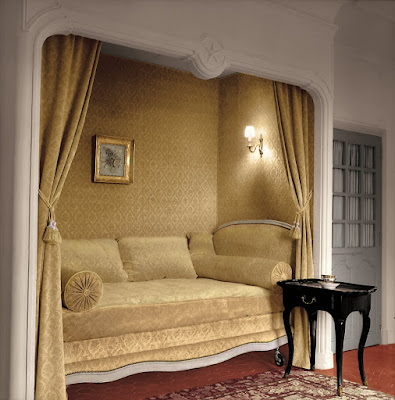







































































.JPG)



























































